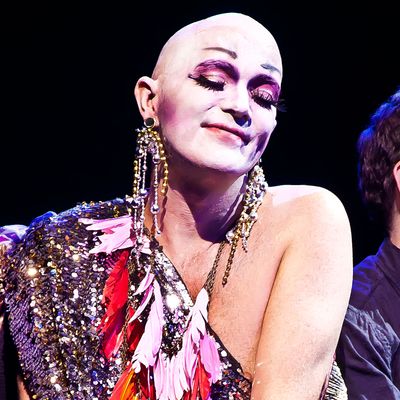
Twenty-two hours into A 24-Decade History of Popular Music, Taylor Mac, wearing a gown of gutted cassette tapes and a headpiece of skulls, guided the audience through a gradually softening refrain of Patti Smith’s song “People Have the Power,” until the packed theater at St. Ann’s Warehouse was filled with a breathless, omnipresent whisper: People have the power. When the final “r” softly died out, and the lights faded momentarily to black, the room was so quiet I might as well have been standing there alone, and yet I had never felt more profoundly connected to a group of fellow audience members.
Since noon on a Saturday morning, we had gathered together for the final performance of this run of A 24-Decade History of Popular Music, 24 hours of nonstop song, dance, and participatory art. By the time we reached the 1980s — that time of neon, MTV, and the AIDS crisis — Mac, his fellow performers, and the audience alike were more than a little ragged. Occasionally, Mac reached for notes that simply weren’t there anymore — his vocal cords having been sanded down by a marathon of 220 other songs. For my part, my back was sore, my ass was numb, and I was pretty sure I stank — although it was hard to separate my own body odor from the collective miasma produced by the other 700 people who had been dancing, eating, fighting, farting, and canoodling in St. Ann’s Warehouse for the previous 21 hours.
Mac informed the audience that our shared physical dissolution was, in fact, the point of the show, an embodied “metaphor for the queer community” that grew out of the AIDS crisis. In that way, A History has been almost 30 years in the making. As a closeted teenage Christian Scientist growing up in Stockton, California, in the 1980s, Mac’s first encounter with out gay people was at an AIDS Walk. Mac was stunned by how AIDS activists created community out of their seeming annihilation — their collective resilience in the face of government abandonment and social stigma. Ever since, Mac had dreamed of a performance that could wholly capture the experience of the AIDS crisis. While 24 hours of performance art could never fully encapsulate 30-plus years of the AIDS crisis, Mac captured the intense emotional catharsis and the failure of the body through his work.
For one thing, A 24-Decade History of Popular Music, Mac drew the audience together with participatory art. At Mac’s behest, we spit Ping-Pong balls into one another’s mouths, slow danced, and fed one another by hand while blindfolded. The emotional charge of these activities, their silliness and poignancy, was thrilling, and made more so by the unpredictability of Mac’s requests. At one point, Mac asked someone to play the part of Stephen Foster in a WWE match against Walt Whitman for the title of “Father of American song.” At another, he invited the oldest member of the audience onstage to teach a dance move to the youngest.
Many reviews of the show have catalogued those experiences, but given the size of the production and the limited stamina of even the most diligent reviewer, no one piece could possibly capture the breadth of its scope and ambition. And that’s as it should be. It’s pointless to catalogue every single activity as they were ultimately tools designed to break down the walls between those of us in attendance. Every hour the show progressed, I felt myself growing closer to the people around me. We were going through something — creating something — together, and over the course of the evening, a strange solemnity began to undergird our mirth. When dinner was served (during post–Civil War Reconstruction, around 9 p.m. on Saturday evening), the woman who handed me my tray looked me in the eye and gently touched my hand for a moment, turning a routine interaction into a momentary connection. It felt like a blessing, and in that moment I was hungry for it.
I was reminded of a radical faerie credo Mac had intoned early in the evening: We don’t worship the noun, but the verb. We don’t worship the artist, but the making of art. We don’t worship the creator, but the act of creation. That night, we had become the noun and the verb, the artist and the art, the creator and the creation. We were simultaneously acting in the show, watching the show, and being forged into something new by the show.
A 24-Decade History of Popular Music is like another epic piece of AIDS-related social practice art, the AIDS Memorial Quilt, which began in 1987 to memorialize the lives lost to HIV/AIDS, and continues to this day. There are over 96,000 handmade panels, each square a testament to a single life. But its true significance lies in the aggregate. It is as much a social network as it is physical quilt, cementing the bonds between activists, artists, and bereaved friends and families around the world. A 24-Decade History of Popular Music is a dynamic manifestation of this community, a movement symbolically re-created in motion and stillness, song and dance, puppets and Ping-Pong balls.
A History was far from perfect. Lines were forgotten, cues were missed, and at one point, the meanderings of a stray balloon managed to upstage the show entirely. But as Mac told us at the start, “Perfection is for assholes.” In high drag-queen style, this was a profound truth disguised as a flip rejoinder. Perfection is the exacting pursuit of a singular vision, a highly subjective opinion masquerading as an objective truth, and the antithesis of the spontaneous acts of co-creation we had engaged in for the last 24 hours. It is a concept that loses all meaning when applied to something as organic and multifaceted as A 24-Decade History of Popular Music — a show that is messy and beautiful, profound and ridiculous, and perfect in its imperfection.

